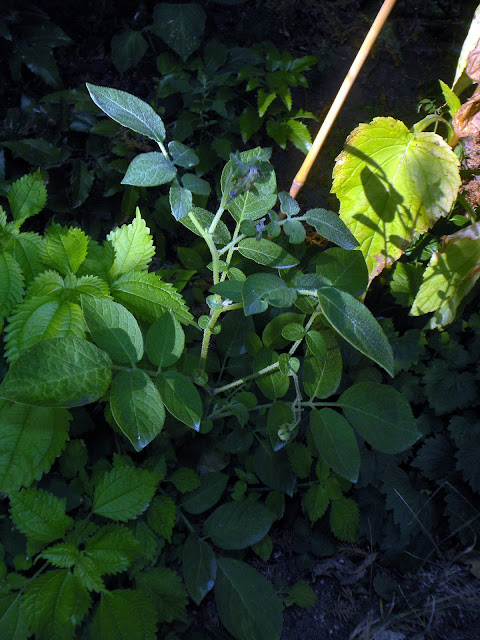The comparison of appearance of tubers of 5 wild species
(more photos bellow)
Some
of them do not creates tubers (series Etuberosa) but numerous other
bear ones. They have various colour and shape, but they are usually
small and they grow up on very long stolons (to 1-2 m = 3-7 ft long),
so they need to be cultivated in pots (to easier find the tubers in
soil). Some of them are edible after cooking, other need a special
processing to become eatable. They often have very good taste. The
fruits (berries in various shape and color) are inedible and mildly
poisonous, the same as leaves.Growing: They can be propagated by true seeds (hard to find) sown surface in pots inside in spring, or tubers planted outside in direct place in April. Some species are very hardy and can survive winters in open garden in zones 6/7. They are often more diseases resistant then common potato (and are hybridized with it to increase a resistance cultivated varieties). They are often self-incompatible so to creating of berries and true seeds they need at least two genetically different plants.
I growed a few species:
Solanum stoloniferum (Mexican Wild Potato)
Species which belongs to taxonomic Longipedicellata series. Herb with long stolons and brown, small (0,25-1,00 inch = 0,6-2,5 cm diameter) tubers. Tubers are edible after cooking and are pleasant eating, tasting somewhat like a sweet chestnuts. Plants grows to about 2,5ft (70cm) tall. They create numerous white flowers with yellow center. Plant native to Central Mexico - dry areas, from 1,800-3000m (=6000-10000 ft) altitude. Species potato blight / alternariose resistant. Can be hybridized with common potato and other wild potatoes. Tubers can survive without protection outside in zones 6/7 and warmer.
(boiled tubers)
Species which belongs to taxonomic Longipedicellataseries. Herb with long stolons and brownish-violet, small (0,25-1,00 inch = 0,6-2,5 cm diameter) tubers. Tubers are edible after cooking and are pleasant eating, tasting somewhat like a sweet chestnuts. Plants grows to about 1 ft (30 cm) tall. They create numerous lavender and violet flowers with yellow center. Plant native to North-Western Mexico and South-Western USA - damp leaf mould, usually under Pinus ponderosa trees, from 1,700-2850m (=5500-9500 ft) altitude. Can be hybridized with other wild potatoes.

Solanum jamesii (Colorado Wild Potato)
Species which belongs to taxonomic Pinnatisecta series. Herb with long stolons and brown, small (0,15-1,20 inch = 0,4-3,0 cm diameter) tubers. Tubers are edible after cooking. Plants grows to about 1ft (30cm) tall and creates numerous flowers in summer. Plant native to N. W. Mexico and S. W. United States - for example coniferous forests at altitude1600 - 2500 meters (5000-8000 ft) in Arizona. Frost hardy to zone 8/9. Species potato blight / alternariose resistant (in a large degree). Can be hybridized with other wild and cultivated potatoes.
Solanum acaule var. caulescens (Devil Potato, Wild Andean Potato)
Belongs to taxonomic Acaulia series. Herb with long stolons and small, whitish (0,5-1,5 inch = 0,4-4,0 cm diameter) tubers. Tubers are edible after cooking. Plants grows to about 1ft (30cm) tall and creates numerous beautiful blue flowers in summer. Species native to Peru, Bolivia and N.W. Argentina - on alpine meadows, by patchs, walls, drainage ditches, cultivated fields, etc. at altitude 2600 - 4650 meters (8666-15500 ft). Something frost hardy. Species potato blight / alternariose resistant (in a large degree). Can be hybridized with other wild and cultivated potatoes.
Belongs to taxonomic Commersoniana series. The herb with long stolons and small brown (0,25-1,50 inch = 0,6-4 cm long) round or ovate tubers. The tubers were eaten (probably after processing) by Indians in the past. Plants grows to about 1,5 ft (45 cm) tall. Plant native to Argentina, Paraguay, Uruguay and southern Brazil – grows as field weed in lowland pastures (from sea level to 2350m = 7800ft altitude). Can be hybridized with other potatoes. Very ornamental plant - flowers showy white with yellow center, leaves glossy, lovely.
Solanum infundibuliforme (Bolivian Wild Potato)
Belongs to taxonomic Cuneoalata series. Herb with long stolons and whitish small (0,25-1,00 inch = 0,6-2,5 cm long) ovate or elongate tubers. The tubers were eaten (probably after processing). Plants grows to about 1 ft (30 cm) tall. Species native to central Bolivia to northern Argentina - in dry rocky areas, from 2350-4300m (= 7800-14300 ft) altitude. Can be hybridized with other wild potatoes. It probably survives outside in zones 6/7 and warmer if kept dry. Drought resistant. It has not flowered in my experience.
Solanum morelliforme (Epiphytic Potato)
Belongs to taxonomic Morelliformia series. Small shade-loving epiphytic or epilytic herb with simple (not pinnate-compound) leaves and little berries. Native to Mexico and Guatemala - wet mountain forests 2000-3000m (= 6666-10000 ft) altitude. I had no success with growing it (small seedling died and has not created the tubers).
There exists very numerous wild species yet. If you have available the seeds or tubers of any of tem please write to me.




































This comment has been removed by the author.
ReplyDeleteAfter boiling the Mountain Kangaroo apple do you eat the seeds?
ReplyDelete